| (Story 8) Bullfrog's (AKA Gordy Snyder) really great world tour - India | |
| Home | Story 1| Story 2 | Story 3 | Story 4 | Story 5 | Story 6 | Story 7 | Story 9 | Story 10 | Story 11 | |
| India – A World of
Extreme Contrasts India – a world of its own; a country of extreme contrasts that hit you right in the face for as long as you are in the country. Arrival in Calcutta from Bangkok; the heat and humidity were stifling. The driver from the Hyatt was holding a name card with my name on it. I was thinking that in the process of possibly changing flights and the arrival time changing, he wouldn't be there. With the luggage safely in the "boot" we covered the approximate 15 km distance in about 15 minutes. International hotels at major airports receive guests at all hours, day and night. It’s routine for people to check in at 2:00 AM or for guests to check in at 2:00 PM in the afternoon. Most notable in the room was the bathroom with glass sink, “sunken” tub and adjacent standup shower. Of course, I connected to the Internet and checked email. Despite the late arrival and working into the early morning hours, I was up early for a very welcome shower. The breakfast buffet, while adequate, was not on a par with those in Thailand, Malaysia and 5-star hotels in China. Having taken only a few bites, I decided to go back to the buffet for toast. When I returned, the plate that I had barely touched had been already cleared from the table. “Where’d my plate go?” I asked. After apologies from the waiter, he stated that he thought that I was done. “Obviously not,” I replied, “I’d hardly had anything.” What a waste, I thought to myself. A little perturbed, I returned for a second round at the buffet. This time the wait staff didn’t touch anything on the table until I said that I was done. After breakfast I walked around the property taking pictures. An extreme contradiction; what’s inside the perimeter walls of the property compared to what is on the other side. Along the side of the hotel was a vacant field where kids were playing soccer. They all had uniforms (of some sort) while some played in their bare feet. My friend, Ajoy Chakrabarti, represents my company in Southeast Asia and is based in Calcutta. He was supposed to have joined me in Thailand and Malaysia, but couldn’t. He was home for the weekend and was to again return to Thailand later in the week. He and his finance, Arundhate, met me the Hyatt. After a delightful lunch, during which time I was given a lesson on baking Indian-style bread, we planned an afternoon of sightseeing prior to catching a late afternoon train to west to Jamshedpur. Checking out of the Hyatt, I only brought what was required for one night and left everything else at the Hyatt. I would be returning the next night. On the start of the tour, we passed a former city dump which had been converted to fields for growing vegetables; people tend the land and sell the produce along the side of the road. I was expecting to see modern, office buildings. It was quite different. The buildings were old, dirty and tired looking. The streets were congested; people walking and on scooters and bicycles. Over crowded busses that hardly stopped long enough for people to jump on and off. Sometimes busses break down and are pushed by the passengers. People pulling carts with big wheels. In one section of town, Park Circus, a tram on rails with overhead power lines. Crossing the rails was so bumpy; the driver brought the car to almost a complete stop. Private cars and the ever present yellow, Ambassador Classic taxi cabs. Referred to as “Human Trucks,” they were everywhere. There was mass confusion in the streets of Calcutta. Horns honking, cars weaving in and out, each driver trying to get an advantage on the other. There were policemen, but very ineffective for either controlling, nor less directing traffic. Cutting off not a problem, just do it. In the central part of town, there’s an elevated highway to carry “through traffic” to the opposite side. The Ganges River flows through Calcutta. We crossed over using the “Rope Bridge,” so named for the use of wire rope for its suspension design. On the west side was Howrah. Our 1st stop was to the Bengal Engineering and Science University where Ajoy studied years ago. After checking with the guards, were drove around the campus. Proudly and with enthusiasm he noted various buildings; dormitories, academic halls, campus center, athletic field and professors’ residences. The apartments where lived. “Big Ben” clock tower showing 12:55 on the dial. There was one major problem. The buildings were in complete disrepair, falling apart and mostly vacant. The grass and underbrush were overgrown. The grounds were totally unkempt. Ponds were stagnant. It must have been very sad for Ajoy to see the total disrepair of the entire campus. Next stop was the nearby botanical garden to see the 250+ year old Great Banyan tree. By showing my passport and registering with the guards at the entrance checkpoint, we were allowed to drive in; everyone else must walk. For those not familiar with the banyan tree, branches go outwards and roots drop to the ground from the branches for support as the tree continues its outward growth. There was a maze of roots, 2,880 prop-roots (and counting) connected to braches connected to the “trunk” of the tree somewhere in the middle. The canopy of the tree was stated to be 420 meters wide, that’s 1,386 feet from one side to the other. The highest branch is 24.4 meters off the ground. The tree was huge. As time was drawing short, the driver took us on the wildest ride through the very crowded streets of Horwah to Calcutta's main train station; horn blaring, cutting others off, using a “police-like” siren – not that anyone paid attention – to gain the slightest advantage while weaving through very congested streets. Arriving at the station with about 10 minutes to spare, porters gathered around the car. For a small fee, 20 or 30 Rupees, they will carry bags, piled high on their head, to the train. Sternly say “No thank you!” and wave them off. We wove our way through a sea of humanity to get to the train; the station smelled of human waste. At one point, Arundhate, held a handkerchief over her nose is an effort to deaden the stench. We located the reserved seats and settled in for the ride. At 17:30 the train started its westward trek to Jamshedpur; only making a few stops along the way. Indians rely heavily on trains to get around. Those not in the comfort of a car with A/C, rode in cars with open windows with bars to prevent people from falling out, limited wooden seating, stuffed-in like sardines. While some sat on the benches, other sat on the floor or stood the entire trip. That’s the way it is in India. Everything in the car was dirty; it was impossible to see out the windows. A man shined shoes for 10 Rupees a pair. Porters in dirty coats served coffee, tea and packaged meals. No thank you. At one station a young, barefooted boy, perhaps 10 or 12 years old, cleaned the floor from one end to the other, crawling on his hands and knees and then begged for tips receiving but few. He had to get off the train while it pulled out of the station. The girl sitting in the seat in front of us looked over the seatback long enough for me to take a picture. She and her family were gone at the next stop. The train pulled into Jamshedpur after 10:00 PM; a driver from the hotel was waiting for me. Ajoy and Arundhate, took a cab; she lives here with her mother and was returning home. The station was teaming with people, everywhere. Some waiting to go somewhere. Others sleeping in the station or on the ground outside; anywhere they could find an empty space. Sleeping on the cement or a piece of cardboard or on a bundle of freight. Nothing better to look forward to the next day except poverty. People by themselves and as families, men and women, boys and girls, young and old, all wearing filthy and tattered clothing. Hundreds, perhaps thousands. It was absolutely the most unbelievable sight I had seen the entire trip! Perhaps some would die overnight. Without dignity, they would be hauled away in the morning when the authorities came through with water hoses for cleaning. Many, no doubt, hadn’t eaten in days, perhaps longer. Their world consisted of what they had on the back, and that was nothing! This experience made my complaint about sleeping on the hardest bed in the world several weeks earlier in Tonghua, China very petty. I had eaten breakfast and lunch that day; I had taken a shower in the morning; I had taken medicine to prevent illness during my trip; I had clean cloths and clean water; I had money in my pocket; I had an air conditioned room in a hotel; I had, I had, I had. These humans had absolutely nothing! And the stench was almost overbearing. After skillfully weaving through traffic, the driver deposited me at the front entrance, and I was warmly greeted by the reception desk clerk of The Regent hotel. “Redefining hospitality” states the hotel literature. “Elegance in the heart of the City.” A solid wood door with an actual key, not plastic. Room 315 was rather small but complete with a mini-bar and the A/C worked. “Do Not Open the Window!” stated a prominently posted sign; otherwise bugs and mosquitoes would get in. Had a good sleep. Be sure to switch-on the hot water 40 minutes before taking a shower. Up the next morning, shower, dress, breakfast and meet others for the drive to the plant. Tata Steel was founded in the mid-1800s by man named Tata. The company provides to the community, gives back lots, hospitals, schools and community events as well as providing employment for thousands. It was stifling at the mill. Everyone sweats profusely. Meet people for future business. Toured the new facility. Back to the construction office, and then return to the hotel for lunch. Ajoy and I took the afternoon train back to Calcutta. For 30 Rupees we hired a porter to carry our bags to the train platform. A shoe-shine boy earned 10 Rupees for cleaning the dust off my shoes. He looked at me as if I should pay him more. In dialect, Ajoy told the boy that the normal price was 5 Rupees and he has “already paid you 10.” The boy moved on but not before I took a picture. When a train on another track pulled into the station, people jumped out to fill water bottles and buy food to eat. The water had a brownish cast to it. I wouldn’t dare drink it. Our train pulled into the station 20 minutes late; we boarded quickly. Half way through the trip the same barefoot boy cleaned the floor; you could hear coins jingle in his hands as he begged for money. Some paid. The man sitting next to me ordered a meal; he didn’t want to pay, choosing instead to argue. Finally, the porter brought the boss. Reluctantly, he handed over the cash. Tried to sleep but couldn’t; dirty car, dirty windows. We were met at Horwah station by company driver; I was deposited at the Hyatt and Ajoy taken home. Checking into room 209, the A/C was at full blast. After dinner, doing work and putting my coat on for warmth, at 2:00 AM I’d had enough of the cold room; a maintenance person came, checked the A/C stated that the control was broken and turned it off. So at 2:30 AM I moved to another room, 258 in the other wing. We returned to Calcutta a day earlier than planned for good reasons. Ajoy’s visa application interview was scheduled for noon at the US Consulate. After waiting longer than a month, he wasn’t about to be a “no show” for the interview. Very high security at the Consulate: Show I.D. and confirm the appointment time. (I had to show my US passport to gain entry.) No cell phones, no cameras, no briefcases; just the support papers for the interview held in your hand. Once inside more check points. After waiting in the queue for about 1-1/2 hours, his interview was completed successfully within 10 minutes. The interviewer was from Alexandria, VA. She and I talked briefly about my trip. Ajoy was to return after 16:00 PM to pick up his passport with 10-year visa securely attached. Some people are grilled intently about why they want to travel to the US; many are denied visas without refund of the processing fee. Secondly, for safety reasons, it was determined that I should fly to Mumbai from Calcutta rather than from Ranchi, the nearest airport to mill in Jamshedpur. Purchasing the new ticket to Mumbai and reconfirming the flight to South Africa from Mumbai took close to 2-1/2 hours. In the US, the entire process of a new ticket and flight confirmation would have taken 10 or 15 minutes. But I was in India. Meanwhile back at the Hyatt one hour later, a 20-minute argument ensued during checkout over faulty equipment and the inconvenience of being moved to a different room at 2:30 AM. An arrogant young manager suggested through body language and tone of voice that I had broken the equipment; I was at fault, not the hotel. In an email to the hotel detailing my complaint, I stated that that manager deserved to be fired for suggesting that I had broken the equipment. “Over objection” the bill was paid, and I was off to the airport for the 20:00 PM flight to Mumbai, glad to leave Calcutta. In Mumbai the temperature and humidity were lower. A staff person from the Leela Hotel helped with the luggage. Within a very short time I was in a comfortable room on the 5th floor, checking email and doing a report on the day’s activities. And the A/C functioned properly. The Leela offered a superb buffet breakfast. Resisting temptation to sample everything is tough but necessary. So far, I’ve lost about 12 pounds. “Keep it up, don’t give in,” I continue to say to myself. Back in the room for only a short time, the phone rang announcing that the driver had arrived for the 2+ hour trip south. On the way by 9:30 AM, a skilled driver was needed to navigate the narrow and crowded streets as we made our way out of Mumbai; cars, busses, trucks, scooters, bicycles, pull carts, people walking and the ever-present Tuk-tuk, three-wheeled, covered taxies, with space up front for the driver and seating in the back for two to six people. Tuk-tuks were everywhere, in the city and in the country. They purr along the highways and byways, sometimes spewing white exhaust from trusty 2-cycle engines. And not just people; sometimes filled with large packages. Several days later, I saw one lady loading baskets of mangoes in the back. Depressing sights continued to present themselves. One-room huts built of sticks or stones and draped with plastic. Squatters in unfinished apartment buildings. Families living under highway bridges. A man lying spread-eagle on the dirt, arms outstretched. He wasn’t moving; the sun shone brightly. People just walked by. I thought to myself that he might be dead. As we continued farther away from the city, the sights took on a primitive beauty unique to India. Yes, the living conditions were difficult but I found it fascinating. Especially the ladies in the bright colored, flowing saris. Businesses occupy every nook and cranny possible. Fruit and vegetable stands abound. Hotels with exotic names like Garden Hotel, Terrace Garden, White Castle, Eden Garden, Golden Bell, Hotel Cosmo and Prince Paradise dot the landscape. Roadside refreshment stands, restaurants, clothing, garments, ceramics and notions. Trees growing along the side of the road were painted with red and white warning strips. A roadside barber shop. Appliances, electronics, cell phones, auto mechanics, too. An ICU for accident, burns, maternity. Even an undertaker who advertised “Day/Night Services” on a black sign with gold lettering over the entrance to his very narrow shop. Wish I had a picture. Farms and businesses. That’s the economy of rural India. Carts pulled by oxen are quite common. Oxen and cattle freely walk the streets, water buffalo too after wallowing in the mud. The Windmill Resort, http://www.nivalink.com/windmill/, was home for the next two nights. Located far from the hustle and bustle of Mumbai, it offers a pool and restaurant for R&R. No internet. Phone calls to the US were cut-off several times. The rates were reasonable, the rooms clean and comfortable and the grounds well kept. My system did not agree with a curry/chicken meal the first night; it was a long day at the mill the next day. And I was back to normal within 24 hours. Needless to say, I didn’t eat any more meals with curry. The Windmill offers accommodations for drivers, but not in a guest room. To the driver’s question, “Do I sleep on the ground?” I answered, “I do not know.” My driver chose to leave the property; he was back and on time both mornings. Where he spent the night I did not ask. Perhaps he slept in the car, I don’t know. With business finished, the return drive to Mumbai was more of the same with one exception. We stopped and bought 12 fresh-picked mangoes from an elderly lady and (we presumed) her granddaughter. I took several pictures. The grandmother said that it was the first time she had ever had her picture taken. Keeping only 2, I gave the other 10 to the driver. I ate mine at the hotel that evening; the sweetest and juiciest I’d ever had. One other sighting during the drive; on two occasions, we briefly followed trucks carrying God Ganesha to new locations. An ornate red and gold umbrella was held over Ganesha’s statue, the truck was filled with people, some with musical instruments. Once back at the Leela and after having a sandwich in the hotel restaurant, I was in bed with the alarm set and wakeup call arranged for midnight. The flight to Johannesburg departed Mumbai at 04:00 AM and I didn’t want to miss it. Off to the airport at 02:00 AM. After checking two suitcases and clearing through security it was up to the business class lounge to wait for the flight. The lounge had a wooden floor, several dozen cushioned chairs and a few tables scattered around the room and coffee and stale-looking sandwiches for anyone who dared. I didn’t. Like everything else in India, a world of its own. Even at 2 AM, the corridors of the airport were patrolled by armed guards, quite common for southeastern Asia airports. Off to South Africa. Cape Town is calling. Have a good flight. 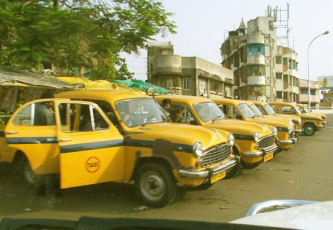 The ever present yellow, Ambassador Classic taxi cabs were everywhere and referred to by some as “Human Trucks." |
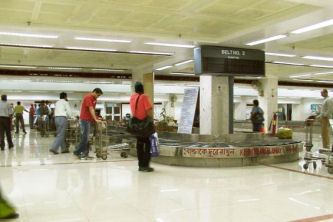 baggage claim area at Calcutta International Airport 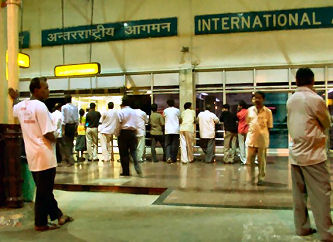 Outside the International arrival building 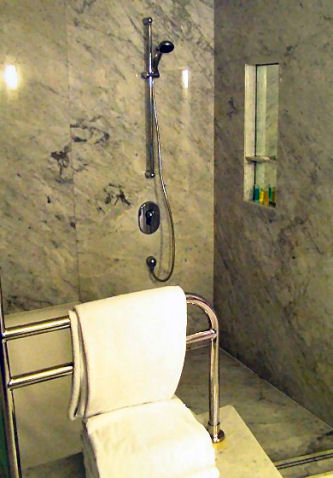 Most notable in the room at the Calcutta Hyatt was the bathroom with glass sink, “sunken” tub and adjacent standup shower with super shower heads that extended out from the wall about 15 inches. 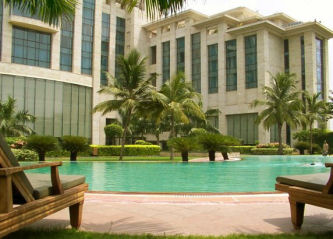 After breakfast I walked around the property taking some pictures. An extreme contradiction; what’s inside the perimeter walls of the property compared to what is on the other side. 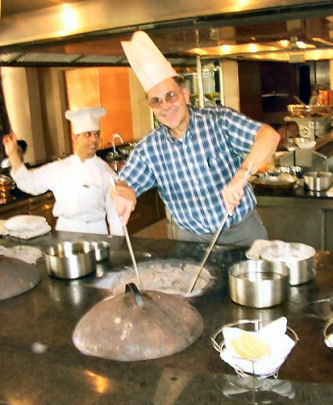 I was given a lesson on baking Indian-style bread. 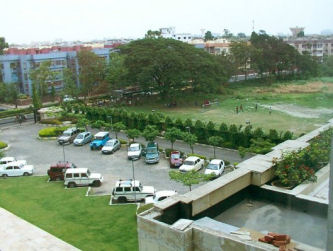 Along the side of the hotel was a vacant field where kids were playing soccer. They all had uniforms (of some sort) while some played in their bare feet. 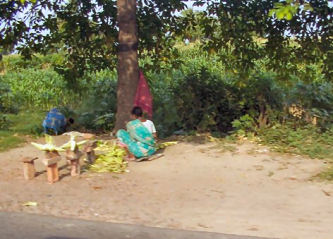 A former city dump had been converted to fields for growing vegetables; people tend the land and sell the produce along the side of the road. 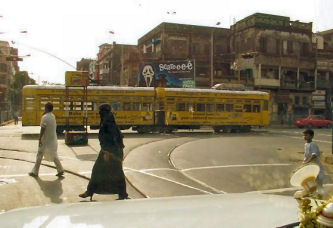 In a section of town called Park Circus was a tram on rails with overhead power lines. Crossing the rails was so bumpy; the driver brought the car to almost a complete stop. 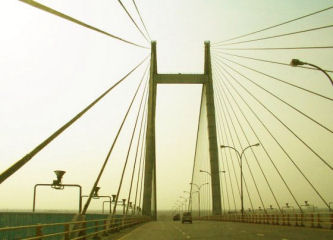 We crossed over the Ganges River on the “Rope Bridge,” so named for the use of wire rope for its suspension design. On the west side was Howrah. 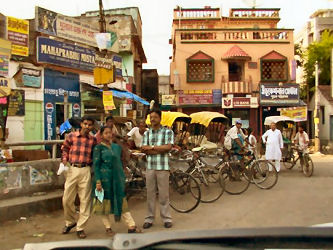 People waiting for public transportation. 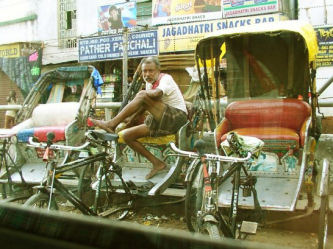 Just another method of public transportation. 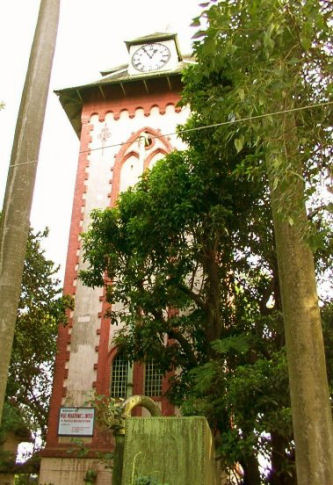 Our 1st stop on the tour around Calcutta was the Bengal Engineering and Science University. After checking with the guards, we drove around the campus. The “Big Ben” clock tower showed 12:55 on the dial. |
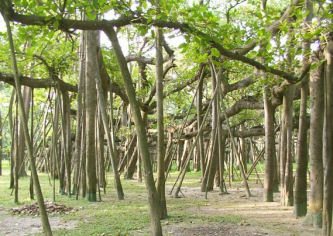 Next stop was the nearby botanical garden to see the 250+ year old Great Banyan tree. There was a maze of roots, 2,880 prop-roots (and counting) connected to braches connected to the “trunk” of the tree somewhere in the middle. |
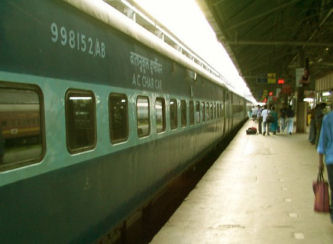 We wove our way through a sea of humanity to get to the train; the station smelled of human waste. We located the reserved seats and settled in for the ride. |
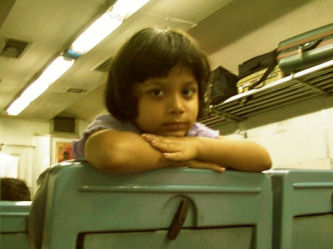 The girl sitting in the seat in front of us looked over the seatback long enough for me to take a picture. She and her family were gone at the next stop.
Right. |
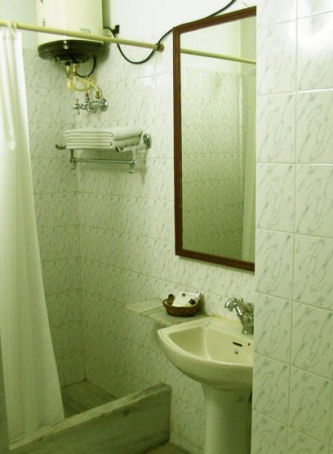 |
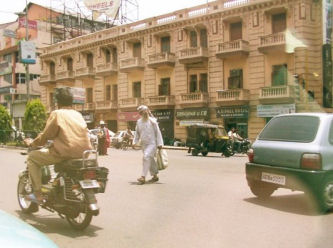 A street of Jamshedpur, India. |
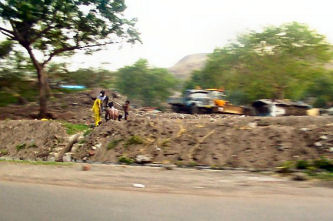 The man taking a bath lives at the edge of a dump. |
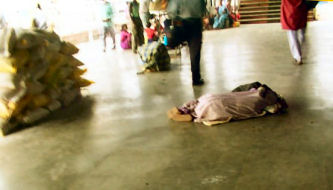 The station was teaming with people, everywhere. Some waiting to go somewhere. Others sleeping in the station or on the ground outside; anywhere they could find an empty space. Sleeping on the cement or a piece of cardboard or on a bundle of freight.
Right. For 30 Rupees we hired a porter to carry our bags to the train platform. |
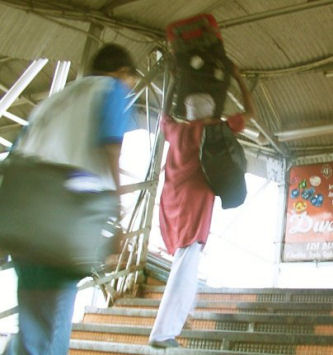 |
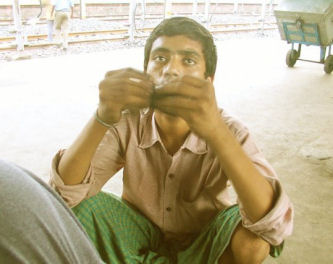 A shoe-shine boy earned 10 Rupees for cleaning the dust off my shoes. He looked at me as if I should pay him more. In dialect he was told that the normal price was 5 Rupees and he has “already paid you 10.” The boy moved on but not before I took a picture. |
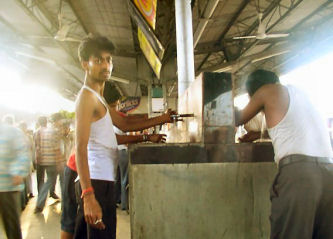 When a train on another track pulled into the station, people jumped out to fill water bottles and buy food to eat. The water had a brownish cast to it |
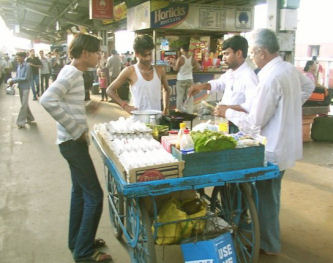 tie in with water bottles being filled. |
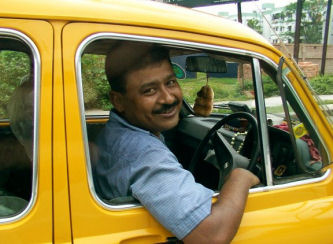 A friendly cab driver in Calcutta. |
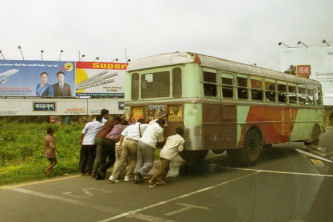 Sometimes busses break down and are pushed by the passengers. |
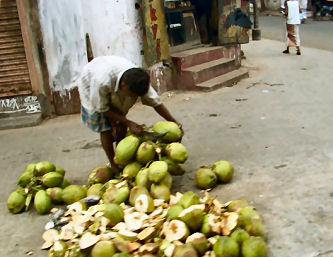 A merchant cuts coconuts and leaves the residue in the streets. |
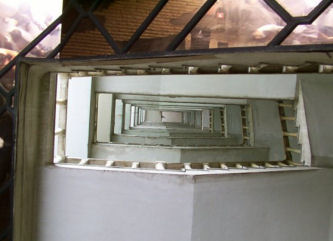 Looking up the stairs of an office building in Calcutta. We took a very slow elevator to the 8th floor. |
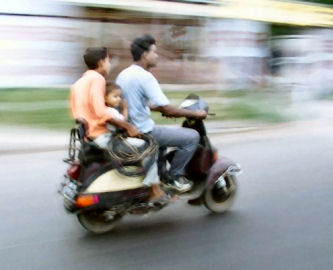 A family rides a scooter through the streets of Calcutta. |
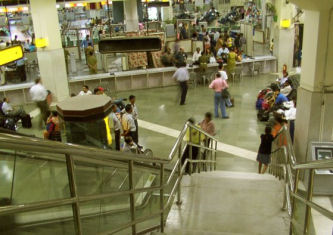 The security check point at the Calcutta airport.
I was glad to |
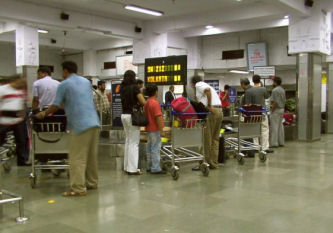 Baggage claim at Mumbai, domestic arrival |
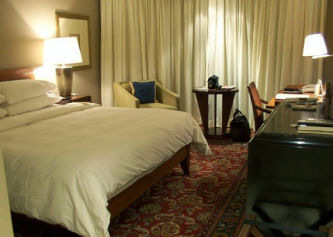 In Mumbai the temperature and humidity were lower. A staff person from the Leela Hotel helped with the luggage. Within a very short time I was in a comfortable room on the 5th floor, checking email and doing a report on the day’s activities. And the A/C functioned properly. |
|
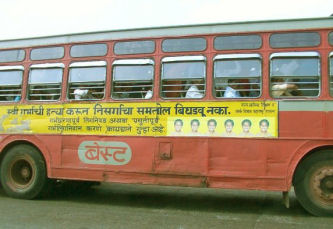 A very crowded bus. |
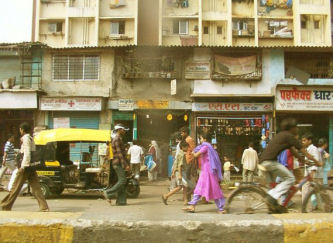 Typical of the busy streets of Mumbai; stores and shops at street level with apartment above. |
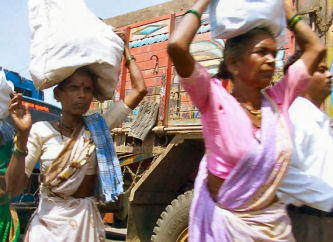 People balance and carry things on their head. |
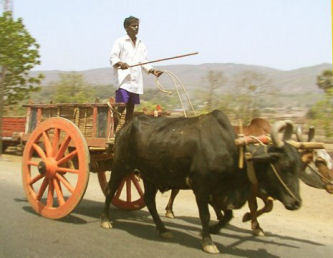 In the rural areas, carts pulled by animals are very common. |
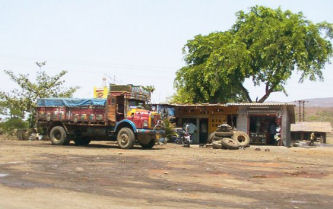 A roadside auto and truck repair shop. |
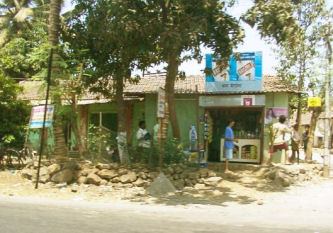 Typical roadside refreshment stand. |
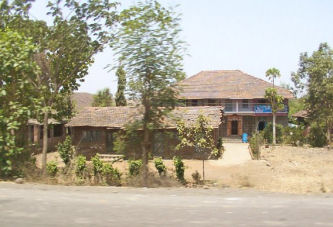 Some people do live in well appointed homes. |
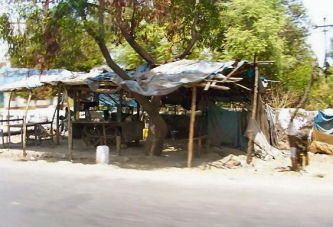 Another roadside stand. |
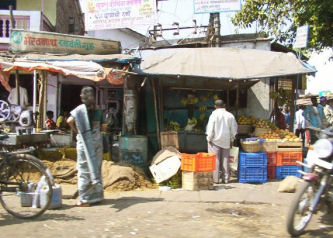 Typical produce stand; note the wide selection. |
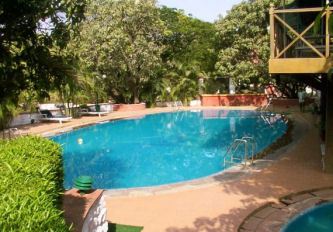 Pool at The Windmill Resort. |
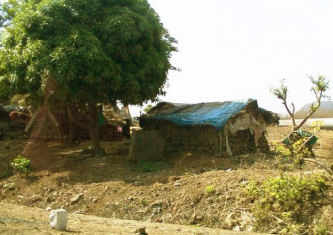 These homes were build using stones, sticks and plastic. |
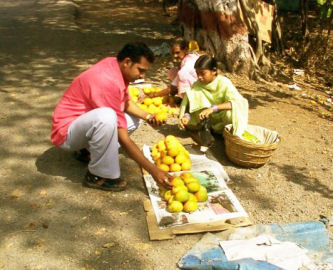 We stopped and bought 12 fresh-picked mangos from an elderly lady and (we presumed) her granddaughter. The grandmother said that it was the first time she had ever had her picture taken. |
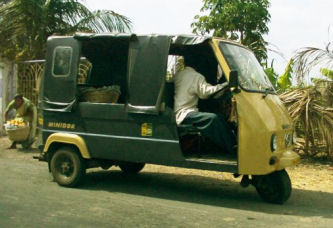 While the driver sat and watched, the lady struggled to load a basketful of mangoes onto the tuk-tuk. |
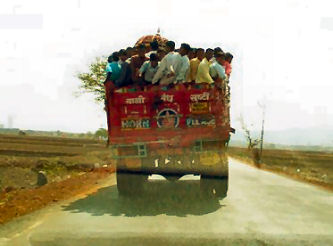 On two occasions we followed trucks carrying God Ganesha to new locations. An umbrella was held over God’s statue. The trucks were filled with people, some with musical instruments. |
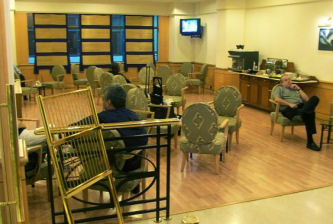 After checking two suitcases and clearing through security it was up to the business class lounge to wait for the flight. It had a wooden floor, several dozen cushioned chairs and a few tables spread around the room and coffee and stale-looking sandwiches for anyone who dared. I didn’t. |
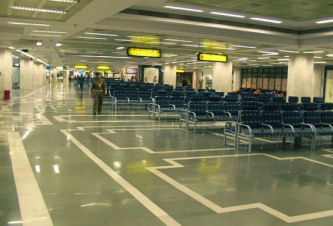 Even at 0 |
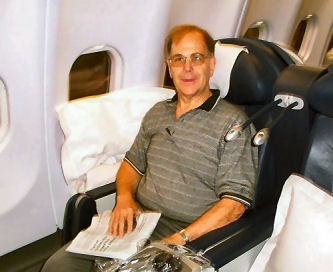
Off to
|
|
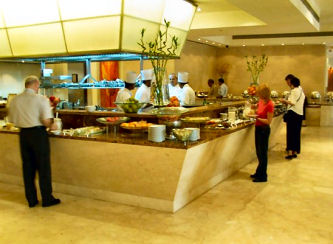 Breakfast buffet at the Leela Hotel.
Breakfast buffet at the Leela Hotel.